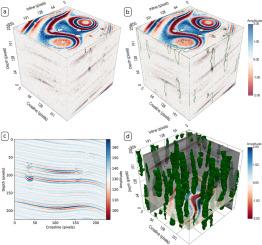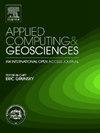Pothole detection and segmentation in the Bushveld Complex using physics-based data augmentation and deep learning
IF 3.2
Q2 COMPUTER SCIENCE, INTERDISCIPLINARY APPLICATIONS
引用次数: 0
Abstract
Potholes are local depression structures that disrupt stratigraphic continuity, such as in layered igneous intrusions. In the Bushveld Complex (South Africa), potholes range from a few to hundreds of meters in width, and may disrupt orebodies, cause ore loss and pose geotechnical challenges. However, potholes are of scientific value as they are proxies of magma chamber processes that are not directly observable. Unfortunately, it is seldom possible to map the full 3D geometry of potholes directly. Reflection seismics has the potential to map many potholes indirectly. However, the accurate segmentation of potholes in seismic data remains unresolved, particularly using geodata science-based methods. Here, we present a prototype segmentation framework that: (1) uses a physics-based, forward modelling method to synthesize 3D reflection seismic data and augments the training data; and (2) implements a standard deep learning, voxel classification-based pothole detection workflow using the data generated in step (1). Both components of the framework are general enough to permit further development, for example, as deep-learning architectures evolve or as the knowledge of potholes improve. We demonstrate that a self-reinforcing feedback loop of knowledge-driven data engineering and deep learning has the potential to overcome data quality issues in supervised tasks of seismic data analysis. We apply the trained model on augmented data to 3D seismic data acquired from a platinum group element Bushveld Complex orebody and demonstrate that automated pothole prediction is practical. Furthermore, physics-based data augmentation, as opposed to inferential types, provides a realistic path to recursive data augmentation that does not incur problems caused by the use of inferential data synthesis, such as model collapse.

使用基于物理的数据增强和深度学习在Bushveld Complex中进行坑洼检测和分割
壶穴是破坏地层连续性的局部凹陷结构,如层状火成岩侵入体。在Bushveld Complex(南非),坑洞的宽度从几米到数百米不等,可能会破坏矿体,造成矿石损失,并对岩土工程构成挑战。然而,凹坑是具有科学价值的,因为它们是岩浆房过程的代表,而不是直接观察到的。不幸的是,很少有可能直接绘制坑洞的完整3D几何形状。反射地震有可能间接地绘制出许多坑洞。然而,地震数据中凹坑的准确分割仍然没有解决,特别是使用基于地球数据科学的方法。本文提出了一种原型分割框架:(1)利用基于物理的正演建模方法合成三维反射地震数据,并对训练数据进行增强;(2)使用步骤(1)生成的数据实现了一个标准的深度学习、基于体素分类的坑洞检测工作流。框架的两个组件都足够通用,可以允许进一步开发,例如,随着深度学习架构的发展或对坑洼的了解的提高。我们证明了知识驱动的数据工程和深度学习的自我强化反馈循环有潜力克服地震数据分析监督任务中的数据质量问题。我们将训练好的增强数据模型应用于Bushveld铂族元素复杂矿体的三维地震数据,并证明了自动坑穴预测是可行的。此外,与推理类型相反,基于物理的数据增强为递归数据增强提供了一种现实的途径,不会产生由使用推理数据合成引起的问题,例如模型崩溃。
本文章由计算机程序翻译,如有差异,请以英文原文为准。
求助全文
约1分钟内获得全文
求助全文
来源期刊

Applied Computing and Geosciences
Computer Science-General Computer Science
CiteScore
5.50
自引率
0.00%
发文量
23
审稿时长
5 weeks
 求助内容:
求助内容: 应助结果提醒方式:
应助结果提醒方式:


